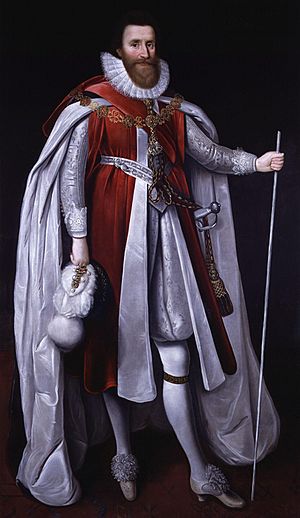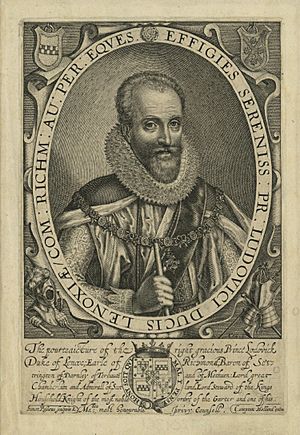Ludovic Stewart, 2nd Duke of Lennox facts for kids
Quick facts for kids
The Duke of Lennox
|
|
|---|---|
 |
|
| Born | 29 September 1574 |
| Died | 16 February 1624 (aged 49) |
| Resting place | Westminster Abbey, London |
| Title | 2nd Duke of Lennox 1st Duke of Richmond |
| Spouse(s) | Sophia Ruthven Jean Campbell Frances Howard |
| Parent(s) | Esmé Stewart, 1st Duke of Lennox and Catherine de Balsac |

Ludovic Stewart, born on September 29, 1574, was an important Scottish nobleman. He became the 2nd Duke of Lennox and later the 1st Duke of Richmond. He was a second cousin to King James VI of Scotland and I of England.
Ludovic played a part in the settlement of Ulster in Ireland. He also helped with the colonization of Maine in New England. Places like Richmond's Island, Cape Richmond, and Richmond, Maine, are named after him. He died on February 16, 1624, at the age of 49. His impressive monument can still be seen in Westminster Abbey in London.
Contents
Who Was Ludovic Stewart?
Ludovic Stewart was the oldest son of Esmé Stewart, 1st Duke of Lennox. His father was a French nobleman with Scottish family roots. Esmé was a close relative and favorite of King James VI of Scotland. This made Ludovic a second cousin to the King.
Ludovic's Life and Work
Early Career in Scotland
After his father passed away in 1583, Ludovic returned from France. He met King James VI of Scotland at Kinneil House. Soon after, he was given important roles in the royal household. He became the High and Great Chamberlain of Scotland. He was also the first Gentleman of the King's Bedchamber.
In 1590, Ludovic wanted to marry Lilias Ruthven. But King James wanted him to marry someone else. The King even had Lilias locked up. However, Ludovic rescued her and they got married. After a few days, the King forgave them.
In 1591, Ludovic became the Lord High Admiral of Scotland. He was involved in trying to arrest Francis Stewart, Earl of Bothwell, who was causing trouble.
In 1593, Ludovic was playing golf in Leith. He got into a fight with John Graham, a judge. Both Graham and a friend of Ludovic's were killed.
Later, King James sent Ludovic to northern Scotland. His job was to deal with the Earls of Huntly and Erroll. Ludovic took control of castles like Ruthven and Inverness. He also held courts in Elgin.
Moving to England
When King James VI of Scotland also became King James I of England in 1603, Ludovic moved with him. King James gave Ludovic new English titles. He became Lord Settrington and Earl of Richmond in 1613. In 1623, he was made Earl of Newcastle and Duke of Richmond.
In 1606, Ludovic welcomed Christian IV of Denmark to England. Christian was the brother of Queen Anne, King James's wife.
Ludovic also received a special permission to make copper coins called "farthings."
Helping with New Settlements
Ludovic was involved in the "Plantation of Ulster" in Ireland. In 1608, he was given land in County Donegal. A town called Newtownstewart in Northern Ireland might be named after him.
He also helped with the colonization of Maine in New England. Places like Richmond Island and Cape Richmond are named after him.
In 1612, Ludovic helped welcome Frederick V of the Palatinate to England. Frederick was going to marry Princess Elizabeth, the King's daughter. Ludovic and other noblemen met him at Gravesend. They brought him to London by boat.
Ludovic's Marriages
Ludovic Stewart was married three times:
- His first wife was Sophia Ruthven. They married before June 1590.
- His second wife was Jean Campbell. They married in 1598. She was a great-granddaughter of King James IV of Scotland.
- His third wife was Frances Howard. They married in 1621.
Ludovic also had a son, Sir John Stewart of Methven, with a woman whose name is not known. Sir John became the governor of Dumbarton Castle. He also built Mongavlin Castle.
Death and Burial
Ludovic Stewart died in 1624 when he was 49 years old. He did not have any children who could inherit his titles. He was buried in Westminster Abbey in London. His tomb is in the Henry VII Chapel. A beautiful monument with statues of him and his wife stands above his burial place.
The Latin words on his monument say that he was a great prince. They also mention his titles and his service to King James. The monument was built by his third wife, Frances Howard.
Titles and Legacy
When Ludovic died, his title of Duke of Richmond ended. But his Scottish title, Duke of Lennox, passed to his younger brother, Esmé Stewart, 3rd Duke of Lennox.
Images for kids
-
Ludovic Stewart's sister, Marie Stewart, Countess of Mar (died 1644).
See also
 In Spanish: Ludovico Estuardo para niños
In Spanish: Ludovico Estuardo para niños




